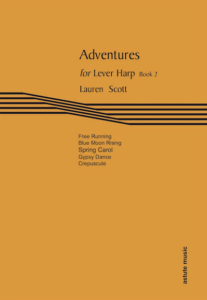A new year is a great time to add something fresh to our repertoire, and, fortunately, several recent publications offer something for everyone. Let’s start with pedal harp.

arrangement of “Virginia Tate” is “interesting and refreshing.”
“Virginia Tate” was written as a one-movement work for solo marimba by Paul Smadbeck. It was named in memory of his mother-in-law who passed away in 1986. The arpeggiated style of the piece lends itself to the harp, and harpist Erin Freund was attracted to elements such as the rising and falling arpeggios and resonant bass. She made an arrangement for pedal harp that was published by Lyon & Healy Publications. The result is 17 pages of music available as a pdf download that takes about eight and a half minutes to play.
The harp is usually considered more resonant in flat keys, but this music starts with the harp having five sharps. There is, nevertheless, a richness to the sound. Much of the melody is in the fourth octave and the right hand is written in the bass clef for several pages. There are fairly frequent key and pedal changes, but none are difficult and pedal markings are included below the staff. Fingering is also provided throughout the piece.
Most of the piece is in 4/4, but there are some meter changes toward the end. The tempo moves along at a pretty good clip and increases in intensity, so this is best suited for the upper-intermediate to advanced player.
The composer sought to create a mood of quiet reflection and Freund successfully sustains that feeling in her harp adaptation. This is an interesting and refreshing addition to the harp repertoire. You can find a recording by Freund on YouTube to listen and decide for yourself.

Lauren Scott has added two more volumes to her Adventures for Lever Harp series. (Book 1 was reviewed in the November/December 2018 issue of Harp Column). Books 2 and 3 contain five pieces each of original music and are also published by Astute Music. This series is for the intermediate to advanced player on a 34-string fully-levered harp tuned to E-flat. However, they are adaptable to other types of harps as well. There are no lever changes within the music, but most pieces require levers to be pre-set at the beginning.
Each piece features one or two techniques or themes. If you’re not sure how to execute a particular technique, there are videos available online at Scott’s website, lauren-
scott-harp.co.uk. You can also listen to a recording of most of the pieces there.
Book 2 starts with an energetic, four-page piece, “Free Running.” It is rhythmic and fast, and Scott includes an explanation of her inspiration for the melody. “A Blue Moon Rises” requires tremolos that are played using a pencil between the strings. The time signature alternates between 5/4 and 7/4 in 3-bar passages based on a Haiku. “Spring Carol” also starts in 7/4 and has some changing meters along with scale glisses. “Gypsy Dance” opens with a cadenza and then develops into a wild gypsy dance featuring glisses strummed against some muffled notes. The final selection in this book is “Crepuscule.” Among the special effects used are harmonics, the whistling effect, gong effect, and playing with fingernails.
These pieces are creative, fun, and challenging. They provide a more advanced lever harp player with the opportunity to “explore the extended harmonic possibilities unique to the lever harp” in Scott’s own words.
She states Book 3 was “inspired by the natural world and the changing seasons.” It begins, appropriately, with “Printemps” and features harmonics. “Red Kite on the Moors” refers to a bird as it soars through the air. Some of the music mimics a bird call. “Neeps and Tatties” is a light and airy tune with frequent grace notes. “The First Snowdrops” refers to the snowdrop flower beginning to push through the ground. The music ends with delicate harmonics. The final piece, “The Leaping Salmon,” uses the left hand to depict salmon swimming upstream as the right hand represents the water current. The xylophonic effect is used here.
This book has a different vibe than Book 2. A visit to Scott’s website will let you decide if this music appeals to you.

And for those who want to play with a friend, Carl Swanson has edited and published a lovely little piece written by Marcel Tournier in 1913. “Promenade à l’automne” is for harp and violin or cello. Available through Harp Column Music, you can download a pdf of the whole set or individual parts. Tournier wrote this piece for one of his young students, and it provides an opportunity for a less advanced student to play chamber music, yet it doesn’t sound simplistic.
Swanson offers a separate versions for lever and pedal harp. There are only a few accidentals, but the pedals are marked in the center of the staff and lever changes are indicated by diamond-shaped notes. He included the cello part on the harp score, but there is also a separate cello part as well as a violin part that could also be played on flute. The typesetting is easy to read.
You can hear a recording of the piece on the Harp Column Music website. This charming piece would make a nice student recital piece. It might also be a useful addition to duo gig music for a wedding or other background music setting.
If any of this piqued your interest, enjoy your new music! •
Jan Jennings has been the music review editor for Harp Column since 1993. She is an active freelancer and teacher, and is the author of The Harpist’s Complete Wedding Guidebook and Effortless Glissing. Email her at
mail@harpbiz.com.






